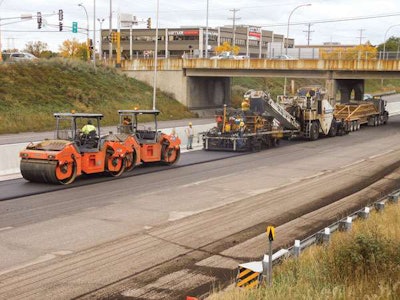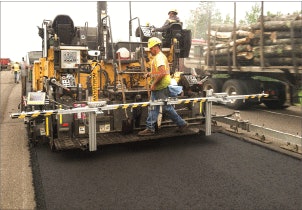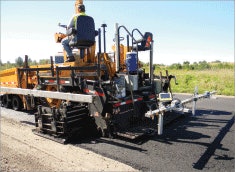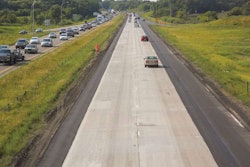A temperature bar can provide a thermal profile in real time.
 A Pave IR bar provided a thermal profile for this mill and overlay project done in October of 2013 by Hardrives Inc. of Rogers, Minnesota, on TH 494 in Bloomington, Minnesota.
A Pave IR bar provided a thermal profile for this mill and overlay project done in October of 2013 by Hardrives Inc. of Rogers, Minnesota, on TH 494 in Bloomington, Minnesota.A system that allows detection of thermal segregation in the asphalt mat – in real time – and records a thermal profile is being used now by some state Departments of Transportation to eliminate inconsistent densities because freshly paved asphalt pavement did not compact properly after becoming too cool and the low temperatures contributed to these low densities.
“We like that it’s something we can give to them that they can use in real time while they’re paving, to make adjustments in their operations,” Johnson says. “We’ll get a better asphalt pavement because our spec currently calls for using cores for density. And we do that a day later. So if there is something going wrong that you can do to improve the pavement in real time, rather than by checking it a day later – we think that’s a good thing.”
The system’s basic components are composed of a bar mounted across the rear of a paver with 12 or more infrared thermometers attached, an on-board computer, a distance encoder, and an optional GPS antenna. The infrared thermometers measure mat temperature at user-defined intervals as the paver moves along. The computer records those temperatures and matches them to distance measurements taken by the distance encoder or the GPS system.
In addition to displaying real-time mat temperature data on the computer screen for the operator or quality control manager, the system can provide a detailed, color-coded thermal profile, foot by foot, of your asphalt mat. The profile can be stored in a memory stick or sent to the cloud, where it can be accessed through the Internet. A contractor can email reports directly to a state DOT at the end of each day. Reports can show tabular details of temperatures and paver stops. End-of-load thermal segregation is definitely visible by colors shown in the profile.
Although the thermal imaging system has seen action in several states in recent years, there are still many states and their contractors, which are not familiar with it. The system was invented by the Texas Transportation Institute (TTI) at Texas A&M University, and was commercialized by MOBA Corp. The Texas DOT has written the Pave IR bar into its specifications, and Texas contractors now operate about 50 of the systems.
Pilot projects with a temperature bar
Minnesota has used the system by including it as a supplemental agreement beginning in 2009. Last year, the state used a specification and put the temperature bar into contracts as a line item. It was used on eight pilot projects last year, and it’s slated for use on 20 projects in 2014.
 Here, a Pave IR bar helps on a mill and overlay project done in June of 2013 by Ulland Brothers Inc. of Cloquet, Minnesota, on TH 33 near Cloquet, Minnesota.
Here, a Pave IR bar helps on a mill and overlay project done in June of 2013 by Ulland Brothers Inc. of Cloquet, Minnesota, on TH 33 near Cloquet, Minnesota.“We are looking for uniformity in our construction practices, to get rid of material segregation and thermal segregation,” Johnson continues. “We’re just trying to get better asphalt densities so that our pavements last the design length of time, or that we get the maximum longevity out of them.”
This year, MOBA plans to market the next-generation of the system in Minnesota. Instead of a beam that reaches across the width of the back of the paver, the new system will have one central temperature sensor that sweeps back and forth across the mat.
“The new system will do exactly the same thing as the beam, except that if a contractor requested to pave wider than one lane, say at 19 or 27 feet, this scanner can handle that without adding extra equipment,” says Paul Angerhofer, product manager of the system for MOBA. “The scanner is only limited by its mechanical range. You would not have to add extra beam extensions across the back of the paver.”
Contractors in Texas do not have the scanner system, mainly because the state’s specification has been written for a beam behind the paver carrying a number of sensors. Angerhofer says he will be working with TTI and the Texas DOT to see how the scanner could fit into their specifications.
States adjust for cyclic density
Meanwhile, other state transportation departments are looking at the Pave IR system with serious interest. The Washington State DOT (WSDOT) has a trial specification for research purposes only, but the state has not attached incentives or penalties to thermal segregation as measured by the system. “WSDOT has used the specification for seven projects,” says Jeff Uhlmeyer, state pavement engineer for WSDOT. He says an eighth project is in progress.
 Northeast Asphalt, in Appleton, Wisconsin, uses a temperature bar to assist with paving a roadway in Wisconsin.
Northeast Asphalt, in Appleton, Wisconsin, uses a temperature bar to assist with paving a roadway in Wisconsin.Five contractors in Washington State have used the Pave IR bar on WSDOT projects and have recognized that the technology can improve asphalt paving quality. “At least on a couple of the projects the contractors took an interest in adjusting their paving operations to reduce cyclic density,” Uhlmeyer says.
Jim Hedderich, technical marketing specialist with MOBA, says South Carolina implemented a specification last year and Lane Construction completed its first project there with the thermal system. “North Carolina visited their job in South Carolina and is looking at implementation of a spec,” Hedderich says. “We have projects coming out in Vermont and New Hampshire this year, requiring both intelligent compaction and the temperature bar. And last year we completed projects in Maine and Pennsylvania and Florida. Oklahoma will do a project this year under the Oklahoma DOT. There continues to be tremendous interest in the system.”
Interest in the system includes catching the attention of the Federal Highway Administration (FHWA) Association of American Safety and Highway Traffic Officials (AASHTO), and the Transportation Research Board (TRB). An implementation plan is underway to further promote the thermal imaging system through the Strategic Highway Research Program (SHRP2).
“In 2007 and 2008, the SHRP2 program kicked off and we proposed to take what we were developing in Texas to the national level, and see if we could do demonstrations,” says Tom Scullion, who heads up research for the thermal imaging system at TTI. For the SHRP2 project, the research team conducted demonstration projects in Florida, Texas, Minnesota, Maine, Virginia and Massachusetts in 2014. Last year, the research team conducted demonstration projects in Pennsylvania and Virginia and did two in 2012.
Scullion says two TTI products were developed with SHRP2. One is the thermal imaging system, and the other is Ground Penetrating Radar to measure asphalt density. “The SHRP2 program named these two products as the top-ranked products from the whole SHRP2 program,” Scullion says. “SHRP2 had these products ranked by AASHTO, and the results came back from the states that these were the top-ranked products.”
Now, Scullion says AASHTO and FHWA have decided to contribute $2 million to an implementation effort that includes thermal imaging of asphalt pavements. At a meeting of TTI, state and federal officials in late February, the discussion centered on which states would be likely candidates for more demonstration projects. “At the meeting…we had Ohio, Maine, Arkansas and Florida present,” Scullion points out. “All these states would be strong candidates to jump on this thing in the next phase of implementation.”
Moreover, the AASHTO standard practice for Continuous Thermal Profile of Asphalt Mixture Construction is being balloted and commented on for inclusion in the new AASHTO documents. Final approval is expected this year. That will present a standard that all agencies can use for reference to put this technology into action.
Contractor reaction to temp bars
Mike Niemi, senior project manager for Brainerd, Minnesota-based Anderson Brothers Construction Co., says his company has chosen to use the Pave IR bar on every project, regardless of whether it is for the DOT. Through the end of 2013, Anderson had used the technology on three state projects – Trunk Highways 89, 27 and 169. The TH 89 project was a mill and overlay over a 10-mile stretch, two lanes wide. Anderson milled out 1 inch of asphalt and used a Volvo paver to replace it with 1-1/2 inches of new asphalt.
Niemi is fond of the system. “We have found that by changing some of our methods, on how we do things, that we have had hardly any severe segregation issues using belly dumps and a windrow pickup machine,” he says. “We have found that we could pave without using a material transfer vehicle.”
He also points out that the bar helps the contractor know when the number of haul trucks is not matched to the paver speed. “When we properly match our trucks to the paver speed, it helps to limit heat segregation, by keeping the paver moving,” Niemi says. “We need to dump the belly dumps so that there are no gaps in the windrow. Keep them tight.”
Niemi says Anderson updated its Pave IR system so that it has Internet capability and can send data to the cloud. The Minnesota DOT requires this now.
Johnson of Minnesota says the state requires continuous thermal profiles behind the screed on all driving lanes. For 2014, the state will provide a $20 incentive for achieving a “good” thermal segregation rating on each 150-foot segment of pavement. The Pave IR system will rate segregation as “good” if the maximum temperature on the mat is between 0 and 25 degrees Fahrenheit higher than the minimum temperature.
Temperature differentials between 25 and 50 degrees rank as “moderate” segregation and differentials of more than 50 degrees get a “severe” ranking. That is the system used by the Texas DOT, and it was picked up by Minnesota.
Minnesota also will penalize contractors by $20 per 150-foot segment for those segments that receive a “severe” rating. “Then the data has to stream up to the cloud,” Johnson says. “That’s a requirement too, because we’ve been doing this intelligent compaction here for the past few years, and we only get 30 to 40 percent of the data if we do it with a manual transfer. So we’re trying to do better than that.”
In Texas, the spec permits contractors who use Pave IR bars to pave at roadway pavement temperatures as low as 32 degrees F.
However the engineer may restrict paving if ambient temperatures are expected to fall below 32 degrees F within 12 hours of paving, says Wade Cooke, quality control manager for Century Asphalt Materials in Houston. With 10 asphalt plants, the company places between 500,000 and 600,000 tons of asphalt per year in the areas around Houston, San Antonio, Austin, and Laredo in South Texas markets.
Century Asphalt has three of the temperature imaging systems, and two of them are Internet-capable, Cooke says. The company has used the system for some five years.
“It’s great,” Cooke says. “Two of our units are actually tied into the cloud, so that I can go online, on the Internet, and view my paving operations from a remote location. As long as I have a laptop or a desktop computer with Internet access, I can watch them pave. I can monitor speed, and placement temperatures live, in real time. It’s convenient too, because I can also take the data at the end of the day, summarize it, and send it to TxDOT on a daily basis. But generally my technicians do that at the end of the shift.
“We’ve learned to control our process a little bit better and it basically tells us if we’re shipping a material that is inconsistent in temperature,” Cooke says. “So as I’m recording this data, and looking at it daily, I can adjust plant settings, trucking and things of that nature that are affecting temperature. It will help us lower the percentage of moderate and severe readings.”
Texas specifications encourage contractors to use a material transfer vehicle, and Century has six Roadtec Shuttle Buggies. Cooke says the state encouraged the use of transfer vehicles prior to the advent of the Pave IR system because it remixes the asphalt prior to paving.)
“We really didn’t think we had an issue with the way we were paving,” Cooke says. “Adjustments were not made to the paving as much as in learning how to use the Pave IR equipment and how to adjust it for compliance purposes.” Cooke says the company’s technicians now are taught to adjust the system to start with the actual mix temperature behind the paver – not the temperature of the asphalt being dumped into the Shuttle Buggy.
“So once we learned to start shooting the temperatures with our thermal guns behind the paver, and adjust the Pave IR bar to within 50 degrees of what was reality behind the machine, we were within specifications consistently,” Cooke says. “We have very few issues related to ‘Severe’ ratings, and I’m within 40 percent or less on ‘Moderate’ readings.”












